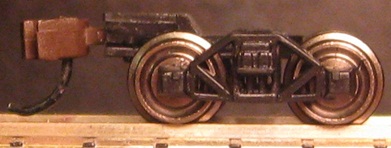

The archbar was the most commonly used truck in the 1890s and early 1900s. Generally speaking, these were used on 40 and 50-ton capacity freight cars. They were comprised of pressed steel and bar components that were bolted together. And although they worked well, archbar trucks required a lot of maintenance. The bolts tended to work loose with the shocks and jolts of operation and required frequent tightening.
Although archbar trucks were built into the 1920s, they were gradually replaced by more advanced designs starting in the teens (and eventually banned from interchange service entirely in 1940). On railroads that were not common carriers (such as logging or other industrial lines), the interchange restrictions did not apply since the trucks did not operate on rails other than the owners'. The Northern Pacific used truss-rod frame MOW cars fitted with archbar trucks into the early 1970's, and many logging railroads used them at least until then.
Athearn, Micro-Trains, and MDC all make decent quality N scale archbar trucks -



Bachmann has made a number of different archbar trucks of varying quality (used on their ACF log cars, 34' "old-timer" freight cars, and boom crane tender) -



Micro-Trains makes two different flavors of narrow gauge (Nn3) archbar trucks (Barber Coleman and Diamond). These are suitable for 1880's-style narrow gauge cars -


Last (and least) are the old Lone Star die-cast "archbar" trucks -

Athearn - wheelbase 10.6mm, frame width 15.9, wheel size 33", axle length 13.65
Micro-Trains - wheelbase 10.2mm, frame Width 16.15mm, wheel size 33", axle length 13.7mm
MDC - wheelbase 10.75mm, frame width 15.91, wheel size 33"mm, axle lenght 13.75mm